Dr David Guex
September 2012 - Dentoscope n°101
Download the PDF
In endodontics, the root treatments as well as the retreatment are perfectly protocol. A well-conducted therapy has a success rate between 70% and 90%. We can improve our disinfection thanks to a size ally: the Erbium:YAG laser. Explanations.
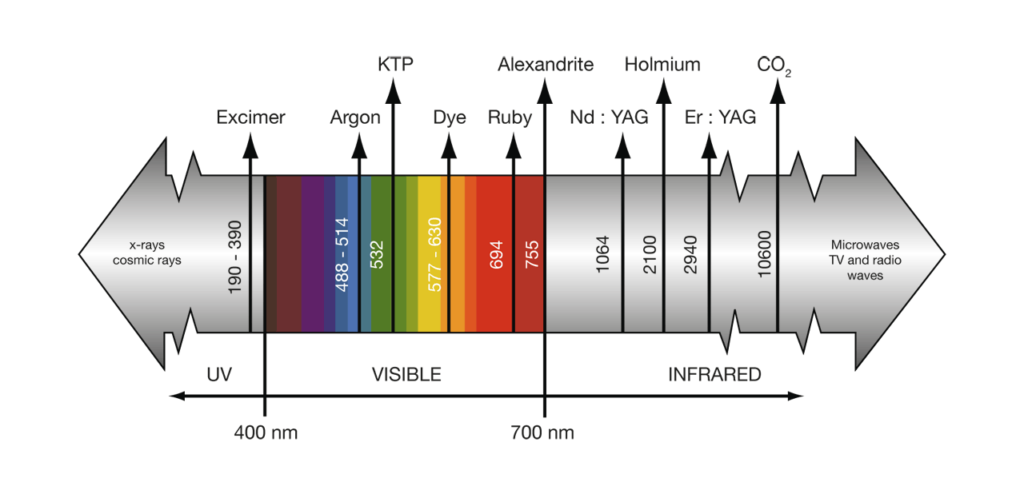
The lasers have been studied very much and are still not well known because they are poorly applied in our profession. On the other hand, their ergonomics was poorly adapted in the clinical field. Since miniaturization of the tips, we can introduce them in the mouth and in the access cavities in spite of blind spots. The principle is to make energy enter the orifice canal in order to activate, propel and disseminate the hypochlorite in the root canal system. There are several categories of laser, and each tool has its own wavelength. This implies that each laser has features and properties of its own. In endodontics, the importance is to lasers whose energy can be transported through fibers or fibered ends: diodes, Ndyag, Ndyap, Erbium lasers; (Fig.1).
PRODUCED EFFECTS BY THE ERBIUM:YAG LASER
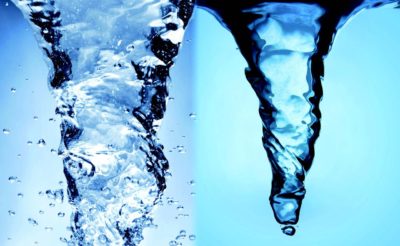
Photo-thermal, photo-chemical and photo-ablative effect. The photo-mechanical effect is among the most interesting in endodontics. The photomechanical effect generates "plasma type" shock waves. The vibratory effect of the wave (10.14 Hz) makes it possible to diffuse the hypochlorite in the canal meanders. The most visible surface effect is the return of the Venturi effect; (Fig.2).
ERBIUM:YAG LASER UTILITY
Erbium:YAG lasers are today the lasers with the most indications in omnipratics and endodontics. Their wavelength is 2940 nanometers, and it lies on the peak of water absorption. When the wavelength encounters a molecule of water, it begins to swell and increases in volume and then explodes. Erbium:YAG is the only laser to make explosive vaporization; (Figs. 3 and 4).
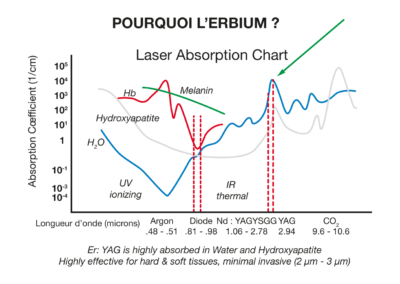

CAUSES OF FAILURE
Fig.5 and 6: We are, however, regularly faced with failures. There are several explanations, the main one being anatomy.
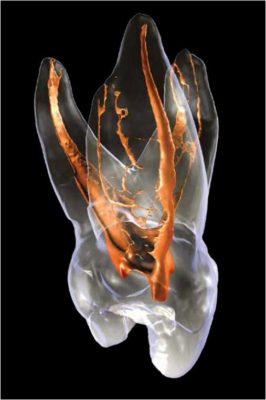
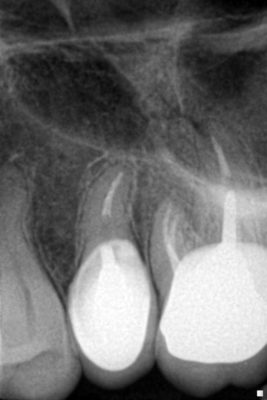
Endodontic anatomy
The challenge of disinfection is the decontamination of non-instrumentable canal ducts because we do not see them. Let 's set for example the first maxillary molar which systematically has four canals.to be more exact, the mesio buccal root is constituted by a canal which has the form of an isthmus, more or less flattened and more or less long, in the vestibulo palatine meaning. If we can instrument the MB1 and MB2, how can we clean and disinfect the isthmus between these two shaped canals? We can destroy this isthmus with ultrasounds, at the risk of weakening the solidity of the root: long and risky. We can allow the hypochlorite to be soaked as long as possible in the two prepared canals: tedious.
CLINICAL CASE
- 26 painful despite the obturation of MB1 and MB2, conventional endodontics conducted without laser therapy, no pathology on 2D radio; (Fig.6).
- Presence of granuloma at CBCT; (FIG 7 and 8).
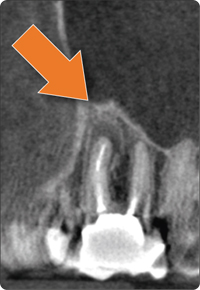
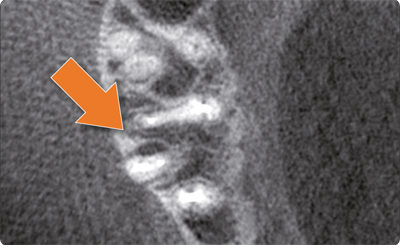
- Apex resection showing the presence of a non-instrumented and infected isthmus; (Fig.9). The interest of the laser will subsequently decrease the number of our surgical procedures by disinfection of this type of isthmus.
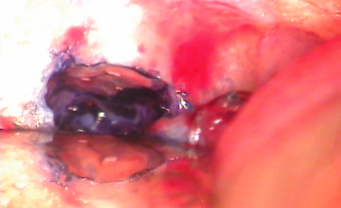
- Retrofilling of the isthmus: disappearance of pain; (Figs. 10 and 11).
We can, while injecting the hypochlorite, make pumping movements with the needle type back and forth from top to bottom: relative efficiency. We can use means of activation and diffusion of hypochlorite: ultrasounds and others.
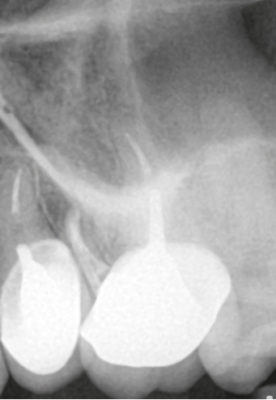

THE CHALLENGE OF CLEANING
Another explanation is the poor elimination of ductal debris generated by rotating instruments. These debris are compacted in the isthmus, and whatever the material used, these debris remain (Paqué et coll.); (Fig.12).These smear layer contain pulp and other organic debris (salivary proteins, gutta, ductal cements, etc.), as well as bacteria, or even worse: the bio-bacterial film; (Fig.13)
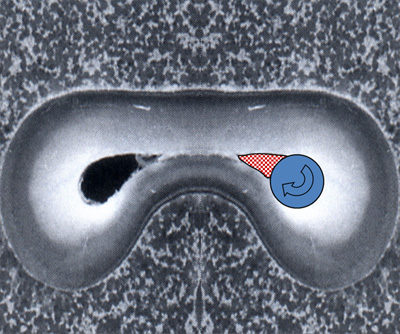
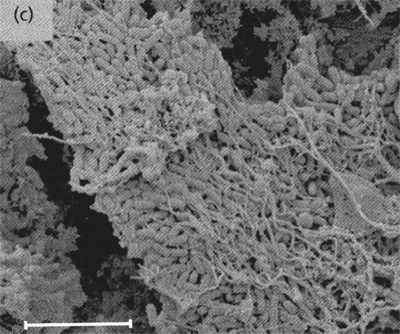
LASER CANAL CLEANING in resin blocks
We have taken a block of transparent resin, virgin of all instrumentation, we sealed the apex in order to have a closed canal, like all the canals of the natural teeth. We put red ink at the canal entrance, and we tried to make it penetrate to the apex. Currently, only a 20/100 shaping allows the irrigant to pass to the apex. We have used all the known methods for diffusing the dye at the apex whose end is 8/100. Only the laser allows diffusion of the dye into this very narrow canal; (Fig.14).this ability is particularly advantageous for the diffusion of the irrigation solution in the accessory canals which have a small diameter; (Fig.15).
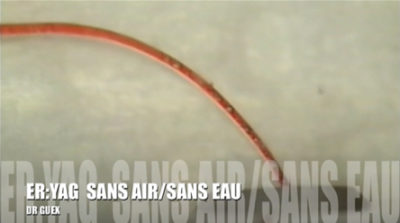

With a fractured instrument in the resin block
We fractured a 25/100 rotary instrument at the apex. We diffused the red ink through the spires of the instrument to the apex thanks to the energy delivered by the laser. This ability makes it possible to diffuse the disinfectant in vivo in inaccessible dentin areas in spite of the presence of broken files. This does not regulate the following steps: how to dry the apical end and obtain a tight apical seal? (Fig.16)
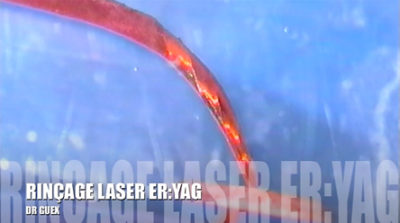
In vivo
The energy of the laser delivered in the irrigation solution highlights a phenomenon: the Venturi effect (named after the Italian physicist Giovanni Battista VENTURI). It is the name given to a phenomenon of fluid dynamics where gaseous or liquid particles are accelerated due to a narrowing of their circulation zone; (Fig.17).
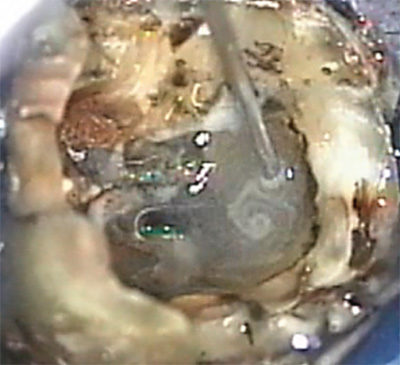
In vivo, this allows us to bring out canals of gutta cones, fractured instruments, smear layer... Anything that favors the obtention of clean canals, free from any impurity, promotes an apical healing; (Fig.18)

There was a large calibrated file fractured in the MB1, activation of the irrigation solution in the MB1 brought out the fractured instruments in the MB2.
Reductions in viable bacterial counts
Modern endodontics seeks by all means to improve canal cleaning. Today, we are looking for additional cleaning of the ancillary and accessory canals by disseminating the disinfecting agents through the main canals. All the known methods and validated processes, as well as techniques in the making are welcome.
I will leave the conclusion to the article published by Meire and col. in the International Endodontic Journal of May 2012: "Sodium hypochlorite proved to be the most effective solution in the elimination of biofilm at Enteroccocus Faecalis , while treatment with Erbium:YAG has also resulted in a large decrease in the same biofilm."
I would like to thank Dr. David BENSOUSSAN, he was the first to introduce me to the Erbium:YAG technology, as well as Dr. Pascal BUFFLIER for reading and correcting this article.
General practitioner in Villié-Morgon (France) since 1999.
Exclusive endodontist in Bron (France) since 2009.
University degree in anatomy and cranio-cervico-facial dissection of the Faculty of Medicine of Paris.
Bibliography
PAQUÉ F., BOESSLER C., ZEHNDER M. :
« Accumulated hard tissue debris levels in mesial roots of mandibulars after sequential irrigation steps » ; International Endodontic Journal, vol 44 number 2 February 2011, p148-153.
« Bacterial killing by several root filling materials and methods in an ex vivo infected root canal model » ; International Endodontic Journal, volume 44 number 12 December 2011, p1 102-1 109.
GUNNAR, BERGENHOLTZ ET COL. :
« Textbook of Endodontology » ; second edition 2010, p100.
MEIRE ET COL. :
« Evaluation of Nd : Yag and Er : Yag irradiation, antibacterial photodynamic therapy and sodium hypochlorite treatment on Enterococcus faecalis biofilms » ; International Endodontic Journal, vol 45, 5 May 2012.
HIMEKA AND COL. :
« Visualization of irrigant flow and cavitation induced by Er : Yag within a root canal model » ; JOE - Volume 37, Number 6, June 2011.
BLANKEN J. ET COL. :
« Laser induced explosive vapor and cavitation resulting in effective irrigation of the root canal » ; Department of Dental Materials Sciences, Academic Centre for Dentistry Amsterdam, University of Amsterdam and VU University Amsterdam, Louwesweg 1, 1 066 EA Amsterdam, The Netherlands, Lasers Surg Med, 2009 Sep ; 41 (7) : 514-9.
RALD D.-P., LAGE-MARQUES J.-L. :
« In vitro evaluation of the effects of the interaction between irrigating solutions, intracanal medication and Er : YAG laser in dentin permeability of the endodontic system » ; Pesqui Odontol Bras, 2003 Jul-Sep ; 17 (3) : 278-85 ; Epub 2003 Dec 16